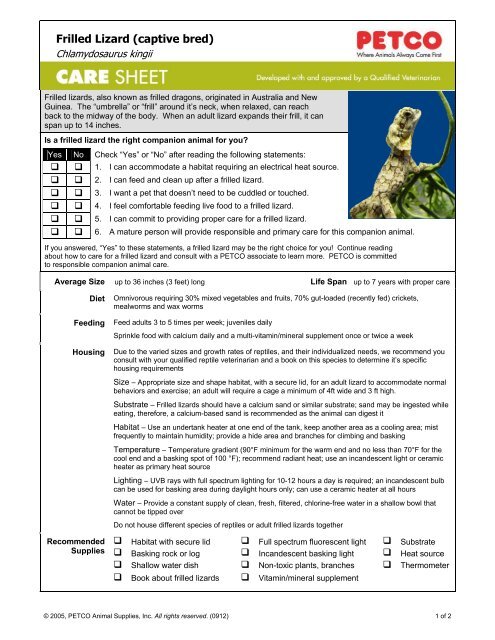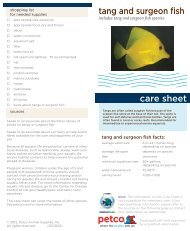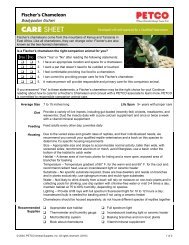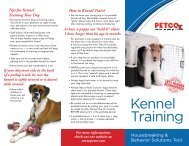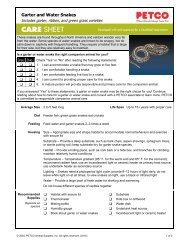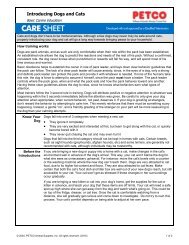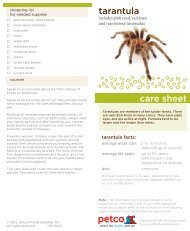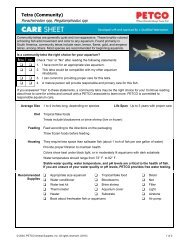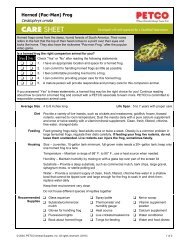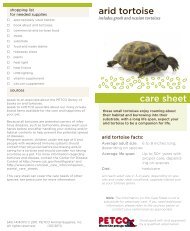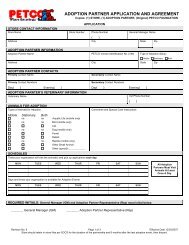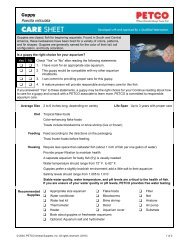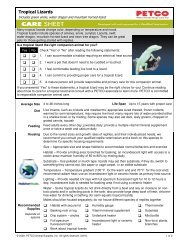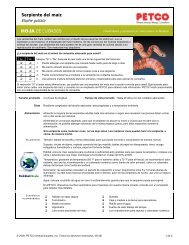You also want an ePaper? Increase the reach of your titles
YUMPU automatically turns print PDFs into web optimized ePapers that Google loves.
<strong>Frilled</strong> <strong>Lizard</strong> (<strong>captive</strong> <strong>bred</strong>)<br />
Chlamydosaurus kingii<br />
<strong>Frilled</strong> lizards, also known as frilled dragons, originated in Australia and New<br />
Guinea. The “umbrella” or “frill” around it’s neck, when relaxed, can reach<br />
back to the midway of the body. When an adult lizard expands their frill, it can<br />
span up to 14 inches.<br />
Is a frilled lizard the right companion animal for you<br />
Yes No Check “Yes” or “No” after reading the following statements:<br />
1. I can accommodate a habitat requiring an electrical heat source.<br />
2. I can feed and clean up after a frilled lizard.<br />
3. I want a pet that doesn’t need to be cuddled or touched.<br />
4. I feel comfortable feeding live food to a frilled lizard.<br />
5. I can commit to providing proper care for a frilled lizard.<br />
6. A mature person will provide responsible and primary care for this companion animal.<br />
If you answered, “Yes” to these statements, a frilled lizard may be the right choice for you! Continue reading<br />
about how to care for a frilled lizard and consult with a PETCO associate to learn more. PETCO is committed<br />
to responsible companion animal care.<br />
Average Size up to 36 inches (3 feet) long Life Span up to 7 years with proper care<br />
Diet<br />
Feeding<br />
Omnivorous requiring 30% mixed vegetables and fruits, 70% gut-loaded (recently fed) crickets,<br />
mealworms and wax worms<br />
Feed adults 3 to 5 times per week; juveniles daily<br />
Sprinkle food with calcium daily and a multi-vitamin/mineral supplement once or twice a week<br />
Housing<br />
Due to the varied sizes and growth rates of reptiles, and their individualized needs, we recommend you<br />
consult with your qualified reptile veterinarian and a book on this species to determine it’s specific<br />
housing requirements<br />
Size – Appropriate size and shape habitat, with a secure lid, for an adult lizard to accommodate normal<br />
behaviors and exercise; an adult will require a cage a minimum of 4ft wide and 3 ft high.<br />
Substrate – <strong>Frilled</strong> lizards should have a calcium sand or similar substrate; sand may be ingested while<br />
eating, therefore, a calcium-based sand is recommended as the animal can digest it<br />
Habitat – Use an undertank heater at one end of the tank, keep another area as a cooling area; mist<br />
frequently to maintain humidity; provide a hide area and branches for climbing and basking<br />
Temperature – Temperature gradient (90°F minimum for the warm end and no less than 70°F for the<br />
cool end and a basking spot of 100 °F); recommend radiant heat; use an incandescent light or ceramic<br />
heater as primary heat source<br />
Lighting – UVB rays with full spectrum lighting for 10-12 hours a day is required; an incandescent bulb<br />
can be used for basking area during daylight hours only; can use a ceramic heater at all hours<br />
Water – Provide a constant supply of clean, fresh, filtered, chlorine-free water in a shallow bowl that<br />
cannot be tipped over<br />
Do not house different species of reptiles or adult frilled lizards together<br />
Recommended<br />
Supplies<br />
Habitat with secure lid Full spectrum fluorescent light Substrate<br />
Basking rock or log Incandescent basking light Heat source<br />
Shallow water dish Non-toxic plants, branches Thermometer<br />
Book about frilled lizards Vitamin/mineral supplement<br />
© 2005, PETCO Animal Supplies, Inc. All rights reserved. (0912) 1 of 2
<strong>Frilled</strong> <strong>Lizard</strong> (<strong>captive</strong> <strong>bred</strong>)<br />
Chlamydosaurus kingii<br />
Normal<br />
Behavior and<br />
Interaction<br />
Arboreal so it is important to provide plenty of non-toxic branches to climb on<br />
When frightened, a frilled lizard may run on its hind legs in an awkward looking gate, earning the<br />
nickname “Bicycle <strong>Lizard</strong>”; many “frilleds” can become so tame and used to their owners, that a frill<br />
display is a very rare occurrence<br />
Never house a smaller frilled lizard with a larger one as the larger one may be very aggressive toward<br />
the smaller lizard<br />
Habitat<br />
Maintenance<br />
Grooming<br />
and Hygiene<br />
Change water in the bowl daily; remove feces daily; thoroughly clean the tank at least once a week:<br />
place the frilled lizard in a secure habitat; scrub the tank and furnishings with a 3% bleach solution; rinse<br />
thoroughly with water, removing all smell of bleach; add clean substrate<br />
Trim a frilled lizard’s claws as needed<br />
<strong>Frilled</strong> lizards regularly shed their skin; ensure humidity of habitat is at appropriate level to allow proper<br />
shedding<br />
To facilitate shedding, bathe in a large container that allows the frilled lizard to immerse its entire body or<br />
provide a shed box, which is essentially a hide box with damp sphagnum moss, that will aid in the<br />
shedding process<br />
Always wash your hands before and after touching your frilled lizard or habitat contents to help prevent<br />
Salmonella and other infectious diseases<br />
Signs of a<br />
Healthy Animal<br />
Common<br />
Health Issues<br />
• Active and alert • Eats regularly<br />
• Healthy skin • Clear nose and vent<br />
• Clear eyes • Body and tail are rounded and full<br />
Health Issue Symptoms or Causes Suggested Action<br />
Gastro-intestinal<br />
Disease<br />
Metabolic<br />
Bone/Vitamin<br />
Deficiency<br />
Respiratory Disease<br />
Runny stools, caked or smeared stool<br />
around the vent area, and loss of appetite<br />
caused by bacterial or parasitic infection.<br />
Inability to absorb calcium due to<br />
insufficient UVB light. If untreated, can<br />
lead to a disorder characterized by<br />
deformities and softened bones. Swollen<br />
limbs and lethargy.<br />
Labored breathing, runny nose, swollen<br />
eyes. Can be caused by temperatures<br />
that are too cold.<br />
Consult your exotic animal<br />
veterinarian.<br />
Provide ample UVB lighting<br />
and consult your exotic animal<br />
veterinarian.<br />
Ensure proper lighting, water<br />
and basking conditions. If<br />
condition persists, consult your<br />
exotic animal veterinarian.<br />
Red Flags<br />
• Weight loss or decreased appetite • Mucus in mouth or nose<br />
• Swelling • Lethargy<br />
• Bumps, sores, or abrasions on skin • Labored breathing<br />
• Paralysis of limbs or tail • Abnormal feces<br />
If you notice any of these signs, please contact your exotic animal veterinarian.<br />
Sources<br />
Giant <strong>Lizard</strong>s by Robert George Sprackland<br />
Your Bearded Dragon's Life: Your Complete Guide to Caring for Your Pet at Every Stage of Life by Liz<br />
Palika and Richard C. Paull<br />
http://www.herpshop.com.au/CareSheets/Frillies.html<br />
Note: The information on this Care Sheet is not a substitute for veterinary care. If you need additional information,<br />
please refer to the above sources or contact your veterinarian as appropriate.<br />
2 of 2 SKU © 2005, PETCO Animal Supplies, Inc. All rights reserved. (0912)


